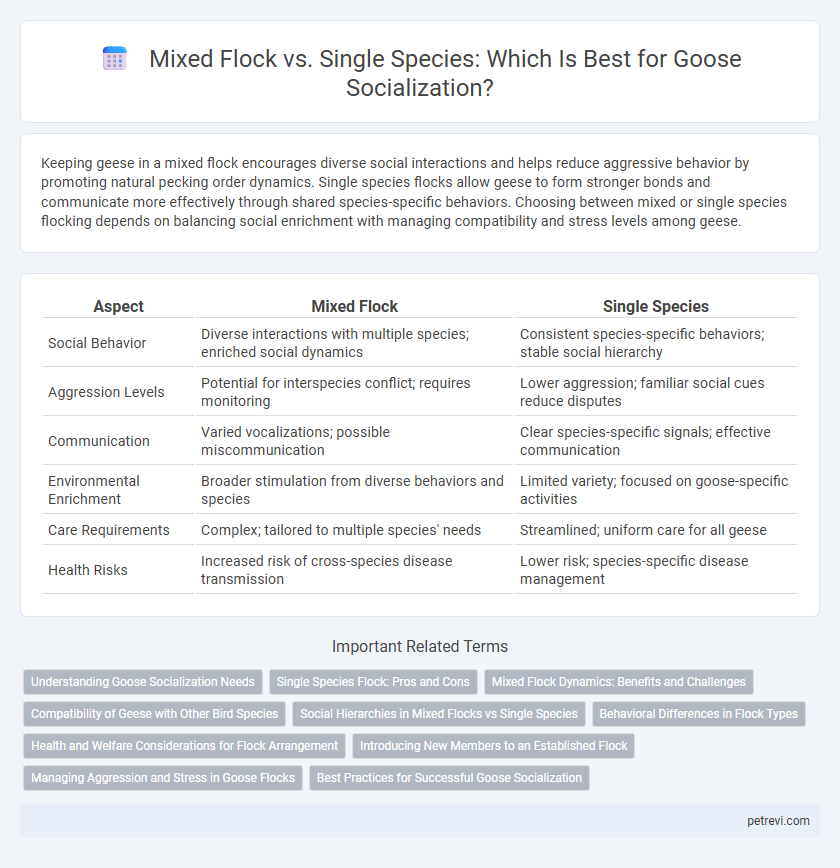Keeping geese in a mixed flock encourages diverse social interactions and helps reduce aggressive behavior by promoting natural pecking order dynamics. Single species flocks allow geese to form stronger bonds and communicate more effectively through shared species-specific behaviors. Choosing between mixed or single species flocking depends on balancing social enrichment with managing compatibility and stress levels among geese.
Table of Comparison
| Aspect | Mixed Flock | Single Species |
|---|---|---|
| Social Behavior | Diverse interactions with multiple species; enriched social dynamics | Consistent species-specific behaviors; stable social hierarchy |
| Aggression Levels | Potential for interspecies conflict; requires monitoring | Lower aggression; familiar social cues reduce disputes |
| Communication | Varied vocalizations; possible miscommunication | Clear species-specific signals; effective communication |
| Environmental Enrichment | Broader stimulation from diverse behaviors and species | Limited variety; focused on goose-specific activities |
| Care Requirements | Complex; tailored to multiple species' needs | Streamlined; uniform care for all geese |
| Health Risks | Increased risk of cross-species disease transmission | Lower risk; species-specific disease management |
Understanding Goose Socialization Needs
Goose socialization thrives best in mixed flocks, where diverse species interactions promote natural behaviors, reduce aggression, and enhance overall well-being. Single-species groups may experience increased stress and dominance conflicts due to limited social dynamics and competition. Recognizing these socialization needs helps in creating environments that mimic natural habitats for optimal health and behavior in geese.
Single Species Flock: Pros and Cons
Single species flocks for geese enhance social bonding and reduce stress by promoting consistent communication and hierarchy within the group. However, these flocks may face limitations in environmental enrichment compared to mixed flocks, potentially leading to boredom or aggressive behaviors if the group size is small. Maintaining a balanced single species flock requires careful management to ensure sufficient space, food resources, and social interaction opportunities.
Mixed Flock Dynamics: Benefits and Challenges
Mixed flock dynamics in goose socialization offer diverse benefits such as increased safety through vigilant watchfulness and enhanced foraging opportunities driven by varied species behaviors. Challenges include potential aggression due to differing dominance hierarchies and competition for resources, which can lead to stress or injury. Successful mixed flocks depend on species compatibility, ample space, and resource availability to maintain social harmony and promote natural behavioral expression.
Compatibility of Geese with Other Bird Species
Geese exhibit complex social behaviors that influence their compatibility with other bird species in mixed flocks. While geese can coexist peacefully with ducks and swans due to similar size and foraging habits, aggressive interactions may occur with smaller or territorial birds. Understanding species-specific social dynamics and territorial instincts is crucial for creating harmonious mixed flocks and minimizing stress or conflict among geese and other birds.
Social Hierarchies in Mixed Flocks vs Single Species
Goose socialization in mixed flocks often results in complex social hierarchies due to interspecies interactions, leading to dynamic dominance structures influenced by size, aggression levels, and species-specific behaviors. In single-species groups, social hierarchies tend to be more stable and predictable, with clear pecking orders established through consistent intra-species communication and territorial displays. Understanding these differences is crucial for managing flock cohesion and reducing interspecies conflicts in mixed environments.
Behavioral Differences in Flock Types
Mixed flocks of geese exhibit increased social complexity due to interspecies interactions, resulting in diversified communication signals and hierarchical structures compared to single-species flocks. Behavioral observations reveal that single-species groups tend to display more uniform aggression patterns and synchronized migration behaviors, enhancing group cohesion and predator avoidance. In contrast, mixed flocks often show varied foraging strategies and adaptive social flexibility, promoting resource sharing and dynamic group dynamics.
Health and Welfare Considerations for Flock Arrangement
Goose health and welfare significantly improve in mixed flocks where species-specific social behaviors reduce aggression and promote natural foraging patterns. Single-species flocks may increase stress due to competition for resources and dominance hierarchies, leading to potential injuries and weakened immune responses. Optimal flock arrangements balance social interaction with environmental enrichment, enhancing overall well-being and minimizing disease transmission risks.
Introducing New Members to an Established Flock
Introducing new geese to an established flock requires careful observation to minimize aggression and stress among birds. Mixing species within a flock can promote diverse social interactions, but single-species groups often exhibit more cohesive behaviors and easier integration. Gradual introductions on neutral territory, coupled with close monitoring, significantly improve acceptance rates and overall flock harmony.
Managing Aggression and Stress in Goose Flocks
Managing aggression and stress in goose flocks involves understanding the social dynamics of mixed flocks versus single-species groups. Single-species flocks typically exhibit more stable hierarchies and reduced territorial disputes, minimizing aggressive behaviors and stress levels among geese. Mixed flocks can increase competition for resources and disrupt established social structures, leading to heightened aggression and elevated cortisol levels indicative of stress.
Best Practices for Successful Goose Socialization
Mixed flocks combining geese with other waterfowl species can enhance social interaction but require careful monitoring to prevent aggression and stress among birds. Single-species flocks foster stronger bonding and clearer communication, reducing conflict and promoting natural behaviors essential for successful goose socialization. Providing ample space, consistent group sizes, and gradual introductions are key practices to optimize harmony and wellbeing in both mixed and single-species goose flocks.
Mixed Flock vs Single Species for Goose Socialization Infographic

 petrevi.com
petrevi.com